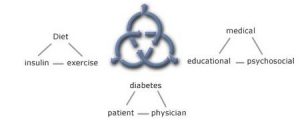The following article, written in 1982 by three officers of the Diabetes Education Study Group ( J. -Ph. Assal, President,- J. Canivet, Vice-President, and M. Berger, Honorary Secretary) traces the history of the DESG from its beginning in 1977, relating both its accomplishments and its conflicts. The objectives of the organization, and the ways in which these could be reached, are outlined with indications of what has been completed as well as what is yet to be done.
History and Aims of the Diabetes Education Study Group
J.-Ph. ASSAL, M. BERGER and J. CANIVET
International Congress Series No.624, Excerpta Medica, Amsterdam, 1982, p.3-7
The Diabetes Education Study Group (DESG) is a section of the European Association for the Study of Diabetes (EASD). Its aim is to help the medical profession to realize the importance of patient education as a therapeutic measure and to analyze the needs and difficulties experienced by medical teams when they have to teach diabetics. The large and varied membership participation in the different medical fields concerned with diabetic education and care from all European areas, North, South, East, and West, provides the unique opportunity for multidimensional studies and approaches to the many facets involved in the successful education of diabetic individuals. This is well illustrated in the article Difficulties encountered with patient education in European diabetic centers (Chapter 13), which outlines the results of 6 workshops conducted by the DESG.
The starting point of the DESG was the annual meeting of the EASD in Geneva in 1977, when a day devoted to patient education was attended surprisingly by over 400 physicians. However, from that beginning in 1977, it took over 2 years before the actual creation of the DESG took place at the First European Symposium on Diabetes Education in Geneva in 1979.
The initial meeting in 1977 made us painfully aware of how mistaken we had been to believe that it would be easy to encompass the whole problem of patient education. As doctors, we had severe problems even to define our objectives for teaching patients. Furthermore, our academic training based on the physiological approach to diseases and our method of thinking (which is often binary, true or false) were of little help for analyzing the educational, sociological and psychological needs of the patients.
The name ‘DESG’
The denomination of ‘Diabetes Education Study Group’ was not our first choice, but was selected after the process of rejecting 3 other names. Each of the first 3 names contained aspects which were not satisfactory to one or another of the medical interests within the DESG. Our developmental passage through a total of 4 names represents elements of almost all the problems involved in patient education.
We first thought of the name ‘Study Group of Teaching Aids for Diabetic Patients’. This name did not last long. After the first DESG meeting, held as an adjunct to the annual EASD meeting in Geneva in 1977, it was evident that teaching aids are only a small part of the general process of learning. Teaching aids alone could not solve the many problems that patients encountered.
‘Study Group on Patient Education’ was the second proposal. This name seemed more appropriate than the first. However, only ‘the receiver’ (the patient) was included in the title without mention of the teacher (doctor/ nurse/dietician) who provides the message. So the name was changed to the ‘Study Group on Doctor-Patient Education’.
The third name represented the 2 poles of the educational process, the teacher and the student, who are linked by the information and feedback which flows between them. Nevertheless, this name also was replaced because several physicians said that teaching patients was not their duty. They viewed problems of inefficiency in patient education as almost always being caused by the patient. To prevent negative reactions from these physicians, the words ‘doctor’ and ‘Patient’ were deleted from the Group’s name, leaving the official title ‘The Diabetes Education Study Group’.
The story of the development of the Group’s name is not just an anecdote. It reflects a deep, almost unspoken problem in patient education. Doctors, nurses or dieticians who are knowledgeable in the field of diabetes and can express themselves easily among colleagues can be unaware of their own difficulties in a new role as teacher.
The emblem
The DESG needed an emblem which would symbolize its activities. We first thought of the famous symbol from Russian history, the ‘Troika’, which depicts a chariot being pulled by a team of 3 horses abreast. The 3 horses would represent diet, insulin, and exercise, equally pulling the wheels of diabetes. However, the horses did not symbolize clearly enough the interdependence among the 3 elements of diet, medicine, and exercise.
The emblem which we chose expresses the interdependence and interaction among 3 areas of equal importance (Fig. 1). A comprehensive treatment of individuals with the chronic illness of diabetes requires of the physician not only sound knowledge and skill in the medical field, but also in the psychosocial and educational domains.
The annual meetings of the EASD provide a remarkable stimulus for investigations into the causes of diabetes and its biochemical abnormalities. However, clinicians who experience the daily frustrations in treating the 10 million diabetics under their care in Europe need more than this yearly stimulus. Diabetic patients present these medical care providers with the psychosocial as well as the medical consequences of the disease. Self-care information and techniques need to be taught so that they are understood and used by these patients. It is in these psychosocial and educational realms that the Diabetes Education Study Group can make great contributions.
All of these biological, psychosocial, and educational aspects of diabetes are interdependent. A patient who is better controlled biochemically feels better psychologically. With a feeling of well-being, the patient is usually more ready and able to learn about the disease. It then follows that the patient who knows his or her diabetes and feels better psychologically is far easier to treat metabolically (Fig. 2).
The DESG needed an emblem which would symbolize its activities. We first thought of the famous symbol from Russian history, the ‘Troika’, which depicts a chariot being pulled by a team of 3 horses abreast. The 3 horses would represent diet, insulin, and exercise, equally pulling the wheels of diabetes. However, the horses did not symbolize clearly enough the interdependence among the 3 elements of diet, medicine, and exercise.
The emblem which we chose expresses the interdependence and interaction among 3 areas of equal importance (Fig. 1). A comprehensive treatment of individuals with the chronic illness of diabetes requires of the physician not only sound knowledge and skill in the medical field, but also in the psychosocial and educational domains.
The annual meetings of the EASD provide a remarkable stimulus for investigations into the causes of diabetes and its biochemical abnormalities. However, clinicians who experience the daily frustrations in treating the 10 million diabetics under their care in Europe need more than this yearly stimulus. Diabetic patients present these medical care providers with the psychosocial as well as the medical consequences of the disease. Self-care information and techniques need to be taught so that they are understood and used by these patients. It is in these psychosocial and educational realms that the Diabetes Education Study Group can make great contributions.
All of these biological, psychosocial, and educational aspects of diabetes are interdependent. A patient who is better controlled biochemically feels better psychologically. With a feeling of well-being, the patient is usually more ready and able to learn about the disease. It then follows that the patient who knows his or her diabetes and feels better psychologically is far easier to treat metabolically (Fig. 2).


